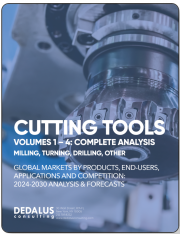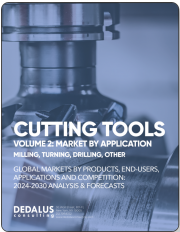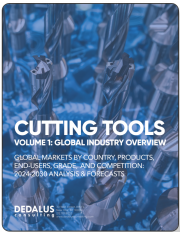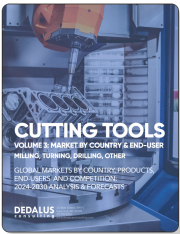
|
시장보고서
상품코드
1574252
커팅 룰 시장 : 용도, 최종사용 산업, 커팅 기술, 재료 유형, 기계 구성, 고객 유형, 판매 채널별 - 세계 예측(2025-2030년)Cutting Rules Market by Application (Commercial, Industrial, Residential), End-Use Industry (Aerospace, Automotive, Construction), Cutting Technology, Material Type, Machine Configuration, Customer Type, Sales Channel - Global Forecast 2025-2030 |
||||||
커팅 룰 시장은 2023년 5,693만 달러로 평가되며 2024년에는 5,983만 달러에 달할 것으로 예상되며, 연평균 4.08%의 CAGR로 성장하여 2030년에는 7,533만 달러에 달할 것으로 예상됩니다.
패키징, 인쇄, 제조 등의 산업에서 사용되는 절단 공정의 중요한 도구인 커팅 룰의 영역에서는 그 범위와 정의를 잘 이해하는 것이 필수적입니다. 이러한 규칙은 골판지, 플라스틱, 판금 등 다양한 소재에서 정밀한 절단 디자인을 만들기 위한 중추적인 역할을 합니다. 커팅 룰의 필요성은 E-Commerce의 성장과 독특하고 친환경적인 제품 표현에 대한 소비자의 기대에 힘입어 고품질 맞춤형 포장 솔루션에 대한 수요가 증가함에 따라 커팅 룰의 필요성이 대두되고 있습니다. 자동차에서 소비재에 이르기까지 다양한 분야에 적용되고 있으며, 제조 공정에서 정확한 절단과 효율성이 가장 중요한 요소로 작용하고 있습니다. 시장 인사이트는 다이 커팅 머신의 기술 발전, 자동화에 대한 투자 증가, 지속가능한 재료에 대한 수요 증가 등 주요 성장 요인을 밝혀냈습니다. 시장 개척의 기회는 내구성이 향상되고 친환경적인 구성의 커팅 룰 개발, 지속가능한 포장 시장의 성장, 제조 공정의 디지털화 등에 있습니다. 시장 개척자들은 커팅 룰의 수명과 정밀도를 향상시키기 위한 제품 개발의 혁신이 권장됩니다. 그러나 원자재 가격 변동, 커팅 룰과 최신 자동화 시스템과의 통합의 복잡성 등의 문제도 여전히 남아 있습니다. 제조업체 간의 경쟁과 까다로운 업계 표준을 충족하기 위한 끊임없는 기술 혁신도 장애물이 되고 있습니다. 혁신을 위한 가장 좋은 분야는 재료 과학, 특히 성능 효율성과 환경적 이점을 모두 제공하는 커팅 룰의 개발입니다. 이는 지속가능성에 대한 소비자 및 규제 당국의 압력이 증가하고 있는 추세와 일치합니다. 추가 연구는 커팅 룰과 다양한 재료 및 첨단 다이 커팅 기술과의 적합성을 최적화하는 데 중점을 두어 향후 성장을 촉진할 것입니다. 시장의 역동적인 특성으로 인해 기업은 경쟁 우위를 유지하기 위해 기술 변화 및 환경 규제에 적응하고 민첩하게 대응해야 합니다.
| 주요 시장 통계 | |
|---|---|
| 기준 연도[2023] | 5,693만 달러 |
| 예측 연도[2024] | 5,983만 달러 |
| 예측 연도[2030] | 7,533만 달러 |
| CAGR(%) | 4.08% |
시장 역학 : 빠르게 진화하는 커팅 룰 시장의 주요 시장 인사이트 공개
커팅 룰 시장은 수요와 공급의 역동적인 상호 작용에 의해 변화하고 있습니다. 이러한 시장 역학의 진화를 이해함으로써 기업은 정보에 입각한 투자 결정, 전략적 의사결정, 새로운 비즈니스 기회를 포착할 수 있습니다. 이러한 트렌드를 종합적으로 파악함으로써 기업은 정치적, 지리적, 기술적, 사회적, 경제적 영역에 걸친 다양한 리스크를 완화하고, 소비자 행동과 그것이 제조 비용 및 구매 동향에 미치는 영향을 보다 명확하게 이해할 수 있습니다.
- 시장 촉진요인
- 자동차 산업과 항공우주 산업의 확대가 절삭 공구 수요를 주도합니다.
- 건설 활동과 인프라 프로젝트 증가로 이어지는 급속한 도시화
- 정밀 절삭 솔루션을 필요로 하는 전자 및 반도체 산업의 성장
- 제조업의 지속가능성 및 폐기물 감소에 대한 관심 증대
- 시장 억제요인
- 현재 시장 도입률과 능력을 능가하는 기술 발전
- 생산과 유통에 영향을 미치는 공급망 혼란과 자재 부족
- 시장 기회
- 자동화 도입 증가로 포장산업 커팅 룰 시장 성장 주도
- 지속가능성에 대한 요구는 제조업에 환경 친화적인 커팅 룰의 새로운 길을 열어줍니다.
- 커팅 룰의 첨단 소재는 중공업의 긴 수명과 성능을 향상시킵니다.
- 시장 과제
- 커팅 룰 시장의 복잡한 규제 준수 및 빈번한 업데이트
- 첨단 기술 통합과 지속적인 혁신으로 인해 커팅 룰 시장의 운영 비용이 급증하고 있습니다.
Porter's Five Forces: 커팅 룰 시장 탐색을 위한 전략 도구
Porter's Five Forces 프레임워크는 커팅 룰 시장의 경쟁 상황을 이해하는 중요한 도구입니다. Porter's Five Forces 프레임워크는 기업의 경쟁력을 평가하고 전략적 기회를 탐색할 수 있는 명확한 방법을 제공합니다. 이 프레임워크는 기업이 시장 내 세력도를 평가하고 신규 사업의 수익성을 판단하는 데 도움이 됩니다. 이러한 인사이트를 통해 기업은 강점을 활용하고, 약점을 해결하고, 잠재적인 도전을 피하고, 보다 강력한 시장 포지셔닝을 확보할 수 있습니다.
PESTLE 분석 : 커팅 룰 시장의 외부 영향력 파악
외부 거시 환경 요인은 커팅 룰 시장의 성과 역학을 형성하는 데 매우 중요한 역할을 합니다. 정치적, 경제적, 사회적, 기술적, 법적, 환경적 요인에 대한 분석은 이러한 영향을 탐색하는 데 필요한 정보를 제공하며, PESTLE 요인을 조사함으로써 기업은 잠재적 위험과 기회를 더 잘 이해할 수 있습니다. 이러한 분석을 통해 기업은 규제, 소비자 선호도, 경제 동향의 변화를 예측하고 선제적이고 적극적인 의사결정을 내릴 준비를 할 수 있습니다.
시장 점유율 분석 : 커팅 룰 시장에서의 경쟁 상황 파악
커팅 룰 시장의 상세한 시장 점유율 분석을 통해 벤더의 성과를 종합적으로 평가할 수 있습니다. 기업은 수익, 고객 기반, 성장률과 같은 주요 지표를 비교하여 경쟁적 위치를 파악할 수 있습니다. 이 분석은 시장의 집중화, 단편화, 통합의 추세를 파악할 수 있으며, 공급업체는 치열한 경쟁 속에서 자신의 입지를 강화할 수 있는 전략적 의사결정을 내리는 데 필요한 인사이트를 얻을 수 있습니다.
FPNV 포지셔닝 매트릭스 : 커팅 룰 시장에서의 벤더 성과 평가
FPNV 포지셔닝 매트릭스는 커팅 룰 시장에서 벤더를 평가할 수 있는 중요한 도구입니다. 이 매트릭스를 통해 비즈니스 조직은 벤더의 비즈니스 전략과 제품 만족도를 기반으로 평가하여 목표에 부합하는 정보에 입각한 의사결정을 내릴 수 있으며, 4개의 사분면으로 벤더를 명확하고 정확하게 세분화하여 전략 목표에 가장 적합한 파트너와 솔루션을 식별할 수 있습니다. 전략 목표에 가장 적합한 파트너와 솔루션을 식별할 수 있습니다.
전략 분석 및 추천 커팅 룰 시장에서 성공의 길을 그리다
절삭공구 시장 전략 분석은 세계 시장에서 입지를 강화하고자 하는 기업에게 필수적인 요소입니다. 주요 자원, 역량 및 성과 지표를 검토함으로써 기업은 성장 기회를 식별하고 개선할 수 있습니다. 이러한 접근 방식을 통해 경쟁 환경의 도전을 극복하고 새로운 비즈니스 기회를 활용하여 장기적인 성공을 거둘 수 있도록 준비할 수 있습니다.
이 보고서는 주요 관심 분야를 포괄하는 시장에 대한 종합적인 분석을 제공합니다.
1. 시장 침투도: 현재 시장 환경의 상세한 검토, 주요 기업의 광범위한 데이터, 시장 도달 범위 및 전반적인 영향력 평가.
2. 시장 개척도: 신흥 시장에서의 성장 기회를 파악하고, 기존 분야의 확장 가능성을 평가하며, 미래 성장을 위한 전략적 로드맵을 제공합니다.
3. 시장 다각화: 최근 제품 출시, 미개척 지역, 업계의 주요 발전, 시장을 형성하는 전략적 투자를 분석합니다.
4. 경쟁 평가 및 정보: 경쟁 상황을 철저히 분석하여 시장 점유율, 사업 전략, 제품 포트폴리오, 인증, 규제 당국의 승인, 특허 동향, 주요 기업의 기술 발전 등을 검토합니다.
5. 제품 개발 및 혁신: 향후 시장 성장을 촉진할 것으로 예상되는 첨단 기술, 연구 개발 활동 및 제품 혁신을 강조합니다.
이해관계자들이 충분한 정보를 바탕으로 의사결정을 내릴 수 있도록 다음과 같은 중요한 질문에 대한 답변도 제공합니다.
1. 현재 시장 규모와 향후 성장 전망은?
2. 최고의 투자 기회를 제공하는 제품, 부문, 지역은 어디인가?
3. 시장을 형성하는 주요 기술 동향과 규제의 영향은?
4. 주요 벤더의 시장 점유율과 경쟁 포지션은?
5. 벤더의 시장 진입 및 철수 전략의 원동력이 되는 수익원과 전략적 기회는 무엇인가?
목차
제1장 서문
제2장 조사 방법
제3장 주요 요약
제4장 시장 개요
제5장 시장 인사이트
- 시장 역학
- 성장 촉진요인
- 성장 억제요인
- 기회
- 과제
- 시장 세분화 분석
- Porter's Five Forces 분석
- PESTEL 분석
- 정치
- 경제
- 사회
- 기술
- 법률
- 환경
제6장 커팅 룰 시장 : 용도별
- 상업용
- 산업
- 주거용
제7장 커팅 룰 시장 : 최종 이용 산업별
- 항공우주
- 항공기 제조
- 유지보수
- 자동차
- 조립 라인
- 부품 제조
- 공사
- 건축공사
- 인프라 개발
- 가구
- 실내장식품
- 목재 절단
- 패키지
- 소비자용 패키지
- 산업용 포장
- 섬유
- 설계와 프로토타이핑
- 직물 재단
제8장 커팅 룰 시장 : 커팅 기술별
- 레이저 절단
- CO2 레이저
- 파이버 레이저
- Nd: YAG 레이저
- 기계 절단
- 다이컷
- 나이프 컷
- 로터리 커터
- 플라즈마 절단
- 기존 플라즈마
- 정밀 플라즈마
- 워터젯 절단
- 연마 워터젯
- 퓨어 워터젯
제9장 커팅 룰 시장 : 소재 유형별
- 복합재료
- 탄소섬유
- 섬유 강화 폴리머
- 유리
- 금속
- 알루미늄
- 구리
- 강철
- 플라스틱
- 열가소성 플라스틱
- 열경화성 플라스틱
- 섬유
제10장 커팅 룰 시장 : 머신 구성별
- 통합 시스템
- 자동 조립
- 독립형 머신
제11장 커팅 룰 시장 : 고객 유형별
- 애프터마켓
- OEM
제12장 커팅 룰 시장 : 판매 채널별
- 직접 판매
- 판매대리점
- 온라인 판매
제13장 아메리카의 커팅 룰 시장
- 아르헨티나
- 브라질
- 캐나다
- 멕시코
- 미국
제14장 아시아태평양의 커팅 룰 시장
- 호주
- 중국
- 인도
- 인도네시아
- 일본
- 말레이시아
- 필리핀
- 싱가포르
- 한국
- 대만
- 태국
- 베트남
제15장 유럽, 중동 및 아프리카의 커팅 룰 시장
- 덴마크
- 이집트
- 핀란드
- 프랑스
- 독일
- 이스라엘
- 이탈리아
- 네덜란드
- 나이지리아
- 노르웨이
- 폴란드
- 카타르
- 러시아
- 사우디아라비아
- 남아프리카공화국
- 스페인
- 스웨덴
- 스위스
- 터키
- 아랍에미리트
- 영국
제16장 경쟁 상황
- 시장 점유율 분석 2023
- FPNV 포지셔닝 매트릭스, 2023
- 경쟁 시나리오 분석
- 전략 분석과 제안
The Cutting Rules Market was valued at USD 56.93 million in 2023, expected to reach USD 59.83 million in 2024, and is projected to grow at a CAGR of 4.08%, to USD 75.33 million by 2030.
In the realm of cutting rules, a critical tool in die-cutting processes utilized across industries like packaging, printing, and manufacturing, a robust understanding of their scope and definition is essential. These rules serve as the backbone for creating precision-cut designs from various materials such as cardboard, plastic, and sheet metal. The necessity for cutting rules is driven by the growing demand for high-quality, custom packaging solutions, fueled by e-commerce growth and consumer expectations for unique and environmentally friendly product presentations. Their application spans sectors ranging from automotive to consumer goods, where precise cuts and efficiency in manufacturing processes are paramount. Market insights reveal key growth factors such as technological advancements in die-cutting machinery, rising investments in automation, and an increasing demand for sustainable materials. Opportunities lie in developing cutting rules with enhanced durability and eco-friendly compositions, tapping into the blossoming sustainable packaging market and the digitalization of manufacturing processes. Recommendations for market players include innovating in product development to enhance the longevity and precision of cutting rules, thus expanding their lifecycle and reducing material waste. However, challenges persist, such as fluctuations in raw material prices and the complexity of integrating cutting rules with modern, automated systems. The competition amongst manufacturers and the constant need for innovation to meet stringent industry standards also present obstacles. The best areas for innovation center around materials science, particularly creating cutting rules that offer both performance efficiency and environmental benefits. This aligns with the increasing consumer and regulatory pressures for sustainability. Further research could focus on optimizing the compatibility of cutting rules with diverse materials and advanced die-cutting technologies, thus driving future growth. The market's dynamic nature encourages firms to remain agile, adapting to technological shifts and environmental directives to sustain competitive advantage.
| KEY MARKET STATISTICS | |
|---|---|
| Base Year [2023] | USD 56.93 million |
| Estimated Year [2024] | USD 59.83 million |
| Forecast Year [2030] | USD 75.33 million |
| CAGR (%) | 4.08% |
Market Dynamics: Unveiling Key Market Insights in the Rapidly Evolving Cutting Rules Market
The Cutting Rules Market is undergoing transformative changes driven by a dynamic interplay of supply and demand factors. Understanding these evolving market dynamics prepares business organizations to make informed investment decisions, refine strategic decisions, and seize new opportunities. By gaining a comprehensive view of these trends, business organizations can mitigate various risks across political, geographic, technical, social, and economic domains while also gaining a clearer understanding of consumer behavior and its impact on manufacturing costs and purchasing trends.
- Market Drivers
- Expansion of the automotive and aerospace industries driving demand for cutting tools
- Rapid urbanization leading to increased construction activities and infrastructure projects
- Growth in the electronics and semiconductor industries requiring precision cutting solutions
- Increasing focus on sustainability and waste reduction in the manufacturing sector
- Market Restraints
- Technological advancements outpacing current market adoption rates and capabilities
- Supply chain disruptions and material shortages impacting the production and distribution
- Market Opportunities
- Increased automation adoption driving growth in cutting rules market for packaging industry
- Sustainability demands opening new avenues for eco-friendly cutting rules in manufacturing
- Advanced materials in cutting rules enhancing longevity and performance for heavy industries
- Market Challenges
- Complex regulatory compliance and frequent updates in the cutting rules market
- Integration of advanced technologies and continuous innovation may lead to high operational costs in the cutting rules market
Porter's Five Forces: A Strategic Tool for Navigating the Cutting Rules Market
Porter's five forces framework is a critical tool for understanding the competitive landscape of the Cutting Rules Market. It offers business organizations with a clear methodology for evaluating their competitive positioning and exploring strategic opportunities. This framework helps businesses assess the power dynamics within the market and determine the profitability of new ventures. With these insights, business organizations can leverage their strengths, address weaknesses, and avoid potential challenges, ensuring a more resilient market positioning.
PESTLE Analysis: Navigating External Influences in the Cutting Rules Market
External macro-environmental factors play a pivotal role in shaping the performance dynamics of the Cutting Rules Market. Political, Economic, Social, Technological, Legal, and Environmental factors analysis provides the necessary information to navigate these influences. By examining PESTLE factors, businesses can better understand potential risks and opportunities. This analysis enables business organizations to anticipate changes in regulations, consumer preferences, and economic trends, ensuring they are prepared to make proactive, forward-thinking decisions.
Market Share Analysis: Understanding the Competitive Landscape in the Cutting Rules Market
A detailed market share analysis in the Cutting Rules Market provides a comprehensive assessment of vendors' performance. Companies can identify their competitive positioning by comparing key metrics, including revenue, customer base, and growth rates. This analysis highlights market concentration, fragmentation, and trends in consolidation, offering vendors the insights required to make strategic decisions that enhance their position in an increasingly competitive landscape.
FPNV Positioning Matrix: Evaluating Vendors' Performance in the Cutting Rules Market
The Forefront, Pathfinder, Niche, Vital (FPNV) Positioning Matrix is a critical tool for evaluating vendors within the Cutting Rules Market. This matrix enables business organizations to make well-informed decisions that align with their goals by assessing vendors based on their business strategy and product satisfaction. The four quadrants provide a clear and precise segmentation of vendors, helping users identify the right partners and solutions that best fit their strategic objectives.
Strategy Analysis & Recommendation: Charting a Path to Success in the Cutting Rules Market
A strategic analysis of the Cutting Rules Market is essential for businesses looking to strengthen their global market presence. By reviewing key resources, capabilities, and performance indicators, business organizations can identify growth opportunities and work toward improvement. This approach helps businesses navigate challenges in the competitive landscape and ensures they are well-positioned to capitalize on newer opportunities and drive long-term success.
Key Company Profiles
The report delves into recent significant developments in the Cutting Rules Market, highlighting leading vendors and their innovative profiles. These include Akhurst Machinery, American Cutting Edge, American Die Technology, Inc, Associated Pacific Machine Corp (APM), Atlas Die LLC, Bar-Plate Manufacturing Company, BOBST, DeltaModTech, Fosber America Inc, Gerber Technology, Harris Dicut Inc, Kampf Schneid- und Wickeltechnik GmbH & Co. KG, Kimblade, Mark Andy Inc, Rotoflex, Sanjo Machine Works, SpanTech, Sysco Machinery Corporation, TSM Corporation, and Wink Stanzwerkzeuge GmbH & Co. KG.
Market Segmentation & Coverage
This research report categorizes the Cutting Rules Market to forecast the revenues and analyze trends in each of the following sub-markets:
- Based on Application, market is studied across Commercial, Industrial, and Residential.
- Based on End-Use Industry, market is studied across Aerospace, Automotive, Construction, Furniture, Packaging, and Textile. The Aerospace is further studied across Aircraft Manufacturing and Maintenance. The Automotive is further studied across Assembly Line and Parts Manufacturing. The Construction is further studied across Building Construction and Infrastructure Development. The Furniture is further studied across Upholstery and Wood Cutting. The Packaging is further studied across Consumer Packaging and Industrial Packaging. The Textile is further studied across Design and Prototyping and Fabric Cutting.
- Based on Cutting Technology, market is studied across Laser Cutting, Mechanical Cutting, Plasma Cutting, and Waterjet Cutting. The Laser Cutting is further studied across CO2 Laser, Fiber Laser, and Nd:YAG Laser. The Mechanical Cutting is further studied across Die Cutting, Knife Cutting, and Rotary Cutter. The Plasma Cutting is further studied across Conventional Plasma and Precision Plasma. The Waterjet Cutting is further studied across Abrasive Waterjet and Pure Waterjet.
- Based on Material Type, market is studied across Composites, Glass, Metals, Plastics, and Textiles. The Composites is further studied across Carbon Fiber and Fiber-Reinforced Polymers. The Metals is further studied across Aluminum, Copper, and Steel. The Plastics is further studied across Thermoplastics and Thermosetting Plastics.
- Based on Machine Configuration, market is studied across Integrated Systems and Stand-Alone Machines. The Integrated Systems is further studied across Automated Assembly.
- Based on Customer Type, market is studied across Aftermarket and OEMs.
- Based on Sales Channel, market is studied across Direct Sales, Distributors, and Online Sales.
- Based on Region, market is studied across Americas, Asia-Pacific, and Europe, Middle East & Africa. The Americas is further studied across Argentina, Brazil, Canada, Mexico, and United States. The United States is further studied across California, Florida, Illinois, New York, Ohio, Pennsylvania, and Texas. The Asia-Pacific is further studied across Australia, China, India, Indonesia, Japan, Malaysia, Philippines, Singapore, South Korea, Taiwan, Thailand, and Vietnam. The Europe, Middle East & Africa is further studied across Denmark, Egypt, Finland, France, Germany, Israel, Italy, Netherlands, Nigeria, Norway, Poland, Qatar, Russia, Saudi Arabia, South Africa, Spain, Sweden, Switzerland, Turkey, United Arab Emirates, and United Kingdom.
The report offers a comprehensive analysis of the market, covering key focus areas:
1. Market Penetration: A detailed review of the current market environment, including extensive data from top industry players, evaluating their market reach and overall influence.
2. Market Development: Identifies growth opportunities in emerging markets and assesses expansion potential in established sectors, providing a strategic roadmap for future growth.
3. Market Diversification: Analyzes recent product launches, untapped geographic regions, major industry advancements, and strategic investments reshaping the market.
4. Competitive Assessment & Intelligence: Provides a thorough analysis of the competitive landscape, examining market share, business strategies, product portfolios, certifications, regulatory approvals, patent trends, and technological advancements of key players.
5. Product Development & Innovation: Highlights cutting-edge technologies, R&D activities, and product innovations expected to drive future market growth.
The report also answers critical questions to aid stakeholders in making informed decisions:
1. What is the current market size, and what is the forecasted growth?
2. Which products, segments, and regions offer the best investment opportunities?
3. What are the key technology trends and regulatory influences shaping the market?
4. How do leading vendors rank in terms of market share and competitive positioning?
5. What revenue sources and strategic opportunities drive vendors' market entry or exit strategies?
Table of Contents
1. Preface
- 1.1. Objectives of the Study
- 1.2. Market Segmentation & Coverage
- 1.3. Years Considered for the Study
- 1.4. Currency & Pricing
- 1.5. Language
- 1.6. Stakeholders
2. Research Methodology
- 2.1. Define: Research Objective
- 2.2. Determine: Research Design
- 2.3. Prepare: Research Instrument
- 2.4. Collect: Data Source
- 2.5. Analyze: Data Interpretation
- 2.6. Formulate: Data Verification
- 2.7. Publish: Research Report
- 2.8. Repeat: Report Update
3. Executive Summary
4. Market Overview
5. Market Insights
- 5.1. Market Dynamics
- 5.1.1. Drivers
- 5.1.1.1. Expansion of the automotive and aerospace industries driving demand for cutting tools
- 5.1.1.2. Rapid urbanization leading to increased construction activities and infrastructure projects
- 5.1.1.3. Growth in the electronics and semiconductor industries requiring precision cutting solutions
- 5.1.1.4. Increasing focus on sustainability and waste reduction in the manufacturing sector
- 5.1.2. Restraints
- 5.1.2.1. Technological advancements outpacing current market adoption rates and capabilities
- 5.1.2.2. Supply chain disruptions and material shortages impacting the production and distribution
- 5.1.3. Opportunities
- 5.1.3.1. Increased automation adoption driving growth in cutting rules market for packaging industry
- 5.1.3.2. Sustainability demands opening new avenues for eco-friendly cutting rules in manufacturing
- 5.1.3.3. Advanced materials in cutting rules enhancing longevity and performance for heavy industries
- 5.1.4. Challenges
- 5.1.4.1. Complex regulatory compliance and frequent updates in the cutting rules market
- 5.1.4.2. Integration of advanced technologies and continuous innovation may lead to high operational costs in the cutting rules market
- 5.1.1. Drivers
- 5.2. Market Segmentation Analysis
- 5.3. Porter's Five Forces Analysis
- 5.3.1. Threat of New Entrants
- 5.3.2. Threat of Substitutes
- 5.3.3. Bargaining Power of Customers
- 5.3.4. Bargaining Power of Suppliers
- 5.3.5. Industry Rivalry
- 5.4. PESTLE Analysis
- 5.4.1. Political
- 5.4.2. Economic
- 5.4.3. Social
- 5.4.4. Technological
- 5.4.5. Legal
- 5.4.6. Environmental
6. Cutting Rules Market, by Application
- 6.1. Introduction
- 6.2. Commercial
- 6.3. Industrial
- 6.4. Residential
7. Cutting Rules Market, by End-Use Industry
- 7.1. Introduction
- 7.2. Aerospace
- 7.2.1. Aircraft Manufacturing
- 7.2.2. Maintenance
- 7.3. Automotive
- 7.3.1. Assembly Line
- 7.3.2. Parts Manufacturing
- 7.4. Construction
- 7.4.1. Building Construction
- 7.4.2. Infrastructure Development
- 7.5. Furniture
- 7.5.1. Upholstery
- 7.5.2. Wood Cutting
- 7.6. Packaging
- 7.6.1. Consumer Packaging
- 7.6.2. Industrial Packaging
- 7.7. Textile
- 7.7.1. Design and Prototyping
- 7.7.2. Fabric Cutting
8. Cutting Rules Market, by Cutting Technology
- 8.1. Introduction
- 8.2. Laser Cutting
- 8.2.1. CO2 Laser
- 8.2.2. Fiber Laser
- 8.2.3. Nd:YAG Laser
- 8.3. Mechanical Cutting
- 8.3.1. Die Cutting
- 8.3.2. Knife Cutting
- 8.3.3. Rotary Cutter
- 8.4. Plasma Cutting
- 8.4.1. Conventional Plasma
- 8.4.2. Precision Plasma
- 8.5. Waterjet Cutting
- 8.5.1. Abrasive Waterjet
- 8.5.2. Pure Waterjet
9. Cutting Rules Market, by Material Type
- 9.1. Introduction
- 9.2. Composites
- 9.2.1. Carbon Fiber
- 9.2.2. Fiber-Reinforced Polymers
- 9.3. Glass
- 9.4. Metals
- 9.4.1. Aluminum
- 9.4.2. Copper
- 9.4.3. Steel
- 9.5. Plastics
- 9.5.1. Thermoplastics
- 9.5.2. Thermosetting Plastics
- 9.6. Textiles
10. Cutting Rules Market, by Machine Configuration
- 10.1. Introduction
- 10.2. Integrated Systems
- 10.2.1. Automated Assembly
- 10.3. Stand-Alone Machines
11. Cutting Rules Market, by Customer Type
- 11.1. Introduction
- 11.2. Aftermarket
- 11.3. OEMs
12. Cutting Rules Market, by Sales Channel
- 12.1. Introduction
- 12.2. Direct Sales
- 12.3. Distributors
- 12.4. Online Sales
13. Americas Cutting Rules Market
- 13.1. Introduction
- 13.2. Argentina
- 13.3. Brazil
- 13.4. Canada
- 13.5. Mexico
- 13.6. United States
14. Asia-Pacific Cutting Rules Market
- 14.1. Introduction
- 14.2. Australia
- 14.3. China
- 14.4. India
- 14.5. Indonesia
- 14.6. Japan
- 14.7. Malaysia
- 14.8. Philippines
- 14.9. Singapore
- 14.10. South Korea
- 14.11. Taiwan
- 14.12. Thailand
- 14.13. Vietnam
15. Europe, Middle East & Africa Cutting Rules Market
- 15.1. Introduction
- 15.2. Denmark
- 15.3. Egypt
- 15.4. Finland
- 15.5. France
- 15.6. Germany
- 15.7. Israel
- 15.8. Italy
- 15.9. Netherlands
- 15.10. Nigeria
- 15.11. Norway
- 15.12. Poland
- 15.13. Qatar
- 15.14. Russia
- 15.15. Saudi Arabia
- 15.16. South Africa
- 15.17. Spain
- 15.18. Sweden
- 15.19. Switzerland
- 15.20. Turkey
- 15.21. United Arab Emirates
- 15.22. United Kingdom
16. Competitive Landscape
- 16.1. Market Share Analysis, 2023
- 16.2. FPNV Positioning Matrix, 2023
- 16.3. Competitive Scenario Analysis
- 16.4. Strategy Analysis & Recommendation
Companies Mentioned
- 1. Akhurst Machinery
- 2. American Cutting Edge
- 3. American Die Technology, Inc
- 4. Associated Pacific Machine Corp (APM)
- 5. Atlas Die LLC
- 6. Bar-Plate Manufacturing Company
- 7. BOBST
- 8. DeltaModTech
- 9. Fosber America Inc
- 10. Gerber Technology
- 11. Harris Dicut Inc
- 12. Kampf Schneid- und Wickeltechnik GmbH & Co. KG
- 13. Kimblade
- 14. Mark Andy Inc
- 15. Rotoflex
- 16. Sanjo Machine Works
- 17. SpanTech
- 18. Sysco Machinery Corporation
- 19. TSM Corporation
- 20. Wink Stanzwerkzeuge GmbH & Co. KG



















